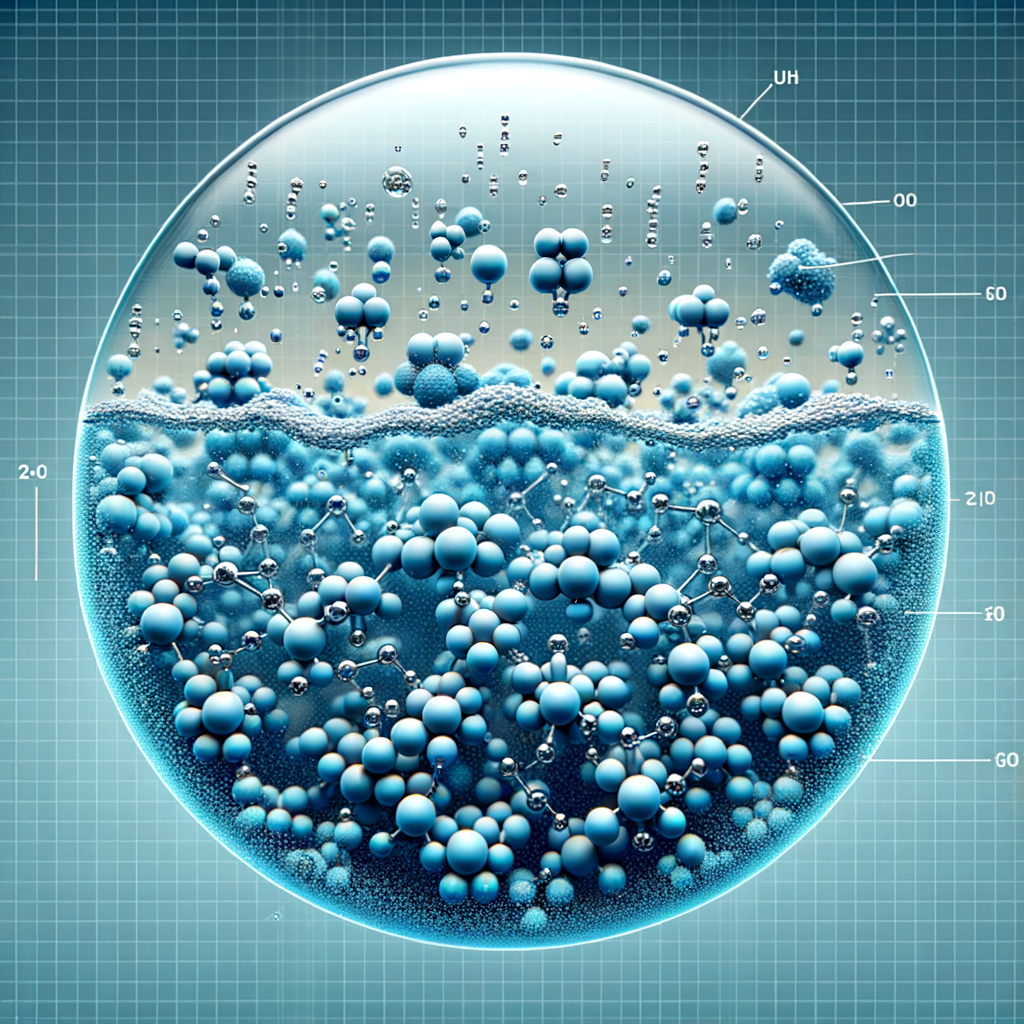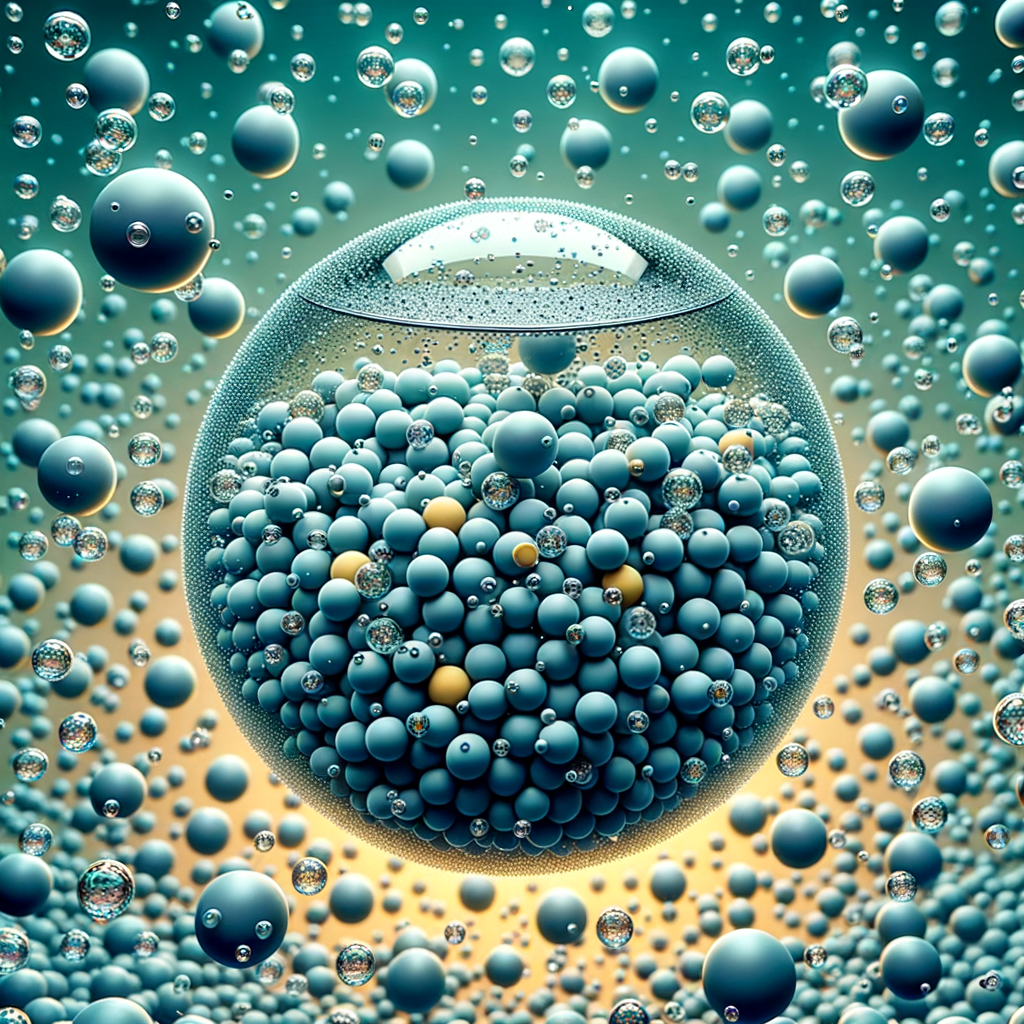Introduction to Uniform Polymer Particles
Uniform Polymer Particles, also known as monodisperse particles, have become indispensable in scientific research and industrial applications.
These particles are characterized by their consistent size, shape, and composition, making them ideal for a wide range of uses, from medical diagnostics to advanced materials engineering.
This article will explore Uniform Polymer Particles' cutting-edge applications in modern science and industry.
What Are Uniform Polymer Particles?
Uniform Polymer Particles are precisely engineered particles with a narrow size distribution. They are typically made from polymers like polystyrene cross-linked with divinyl benzene (DVB), which provides them with excellent chemical stability and durability.

These particles are often used as calibration standards in various analytical techniques due to their consistent properties and NIST traceability.
Understanding the Particle Structure
In the case of Uniform Polymer Particles, the structure is highly controlled, featuring consistent size, shape, and chemical composition. These particles are typically made from polymers such as polystyrene that are cross-linked with divinylbenzene (DVB), providing stability and uniformity.
This precise structure allows them to perform effectively in various applications such as laser diffraction analysis, drug delivery, and quality control, ensuring accurate and reliable results in both scientific and industrial settings. Explore more about these particles and their applications
Key Properties of Uniform Polymer Particles
- Consistent Size Distribution: The particles have a uniform size range, making them ideal for applications requiring precise measurements.
- Chemical Stability: Cross-linked polymers like polystyrene-DVB offer excellent resistance to chemical degradation.
- Optical Properties: They have a specific refractive index (1.59 at 589 nm) and density (1.05 g/cm³), making them suitable for optical applications.
- NIST Traceability: Many Uniform Polymer Particles are NIST traceable, ensuring accurate calibration in analytical instruments
How Does Laser Diffraction Analyze Particle Size?
Laser diffraction has emerged as the gold standard for particle size analysis across numerous industries due to its speed, reliability, and broad measurement range. This non-destructive technique measures particles suspended in liquids, dry powders, or aerosols by analyzing their light scattering patterns.
When laser light interacts with particles, it scatters at angles inversely proportional to particle size - larger particles produce intense scattering at small angles, while smaller particles scatter less intensely but at wider angles.

Modern instruments collect this scattered light using an array of detectors and convert the data into particle size distributions using sophisticated mathematical models. The technique's popularity stems from its ability to analyze millions of particles in seconds, providing statistically robust results that can detect subtle changes in manufacturing processes.
Principles of Laser Diffraction
The fundamental principle of laser diffraction is based on the Fraunhofer and Mie theories of light scattering. When a coherent light source (laser) passes through a dispersed sample, each particle scatters light in a pattern determined by its size, shape, and optical properties.
Fraunhofer approximation works well for larger particles (>10 μm), while Mie theory provides more accurate results for smaller particles by accounting for refractive index differences between particles and the surrounding medium.
The scattered light creates a unique diffraction pattern that's captured by precisely positioned detectors, with forward scattering dominated by larger particles and wide-angle scattering by smaller ones.
The resulting intensity data undergoes mathematical transformation using matrix inversion algorithms to generate volume-based particle size distributions.
Importance of Particle Size Distribution
Particle size distribution (PSD) is critical across industries because it directly influences product performance, quality, and safety. In pharmaceuticals, PSD affects drug dissolution rates, bioavailability, and stability - parameters that determine therapeutic efficacy and shelf-life.
For industrial materials like ceramics, cement, and catalysts, particle size distribution controls surface area, reactivity, and mechanical strength, directly impacting performance and durability.
Environmental monitoring relies on PSD analysis to evaluate pollutants and their potential health impacts based on inhalation and deposition patterns. Laser diffraction's ability to rapidly generate reproducible PSD data enables manufacturers to implement statistical process control, detecting variations early before they cause product defects.
Modern quality systems increasingly require validated particle sizing methods, making accurate PSD measurement essential for regulatory compliance.
Measuring Size Range from Microns to Millimeters
Modern laser diffraction instruments demonstrate remarkable versatility by measuring particles spanning three orders of magnitude (typically 0.1-3000 μm) in a single measurement.
This broad-range capability eliminates the need for multiple analytical techniques when characterizing complex samples. The optical design incorporates multiple light sources (often red and blue lasers) and optimized detector arrangements to accurately capture both forward and wide-angle scattering simultaneously.

For accurate measurements across this range, proper sample preparation is critical - samples must be appropriately dispersed to break up agglomerates without damaging primary particles. Calibration using traceable standards like uniform polymer particles ensures measurement accuracy throughout the instrument's range.
Advanced instruments incorporate multiple measurement modes (wet and dry dispersion) with automated sample handling systems to analyze diverse materials from fragile emulsions to abrasive minerals
Scientific Applications of Uniform Polymer Particles
1. Laser Diffraction and Particle Size Analysis
One of the most common applications of Uniform Polymer Particles is in laser diffraction techniques, where they serve as calibration standards. These particles are used to measure the size distribution of materials in pharmaceuticals, cosmetics, and environmental samples.

The uniform size distribution ensures accurate and repeatable measurements, critical for quality control and research.
2. Biomedical Research and Drug Delivery
In the field of biomedical research, Uniform Polymer Particles are used as carriers for drug delivery systems. Their consistent size allows for the controlled release of drugs, while their biocompatibility makes them suitable for use in human tissues. They are also used in diagnostic assays, where they act as markers for detecting diseases.
3. Chromatography and Separation Science
Uniform Polymer Particles are widely used in chromatography as stationary phases. Their uniform size and surface properties allow for the efficient separation of complex mixtures, making them essential in analytical chemistry and pharmaceutical research.
4. Advanced Materials and Nanotechnology
In nanotechnology, Uniform Polymer Particles are used to create advanced materials with specific properties. They can be used as templates for the synthesis of nanoparticles, or as building blocks for creating structured materials with precise architectures.
Industrial Applications of Uniform Polymer Particles
1. Quality Control in Manufacturing
In industrial settings, Uniform Polymer Particles are used to calibrate and validate particle size analyzers. This is critical in industries like pharmaceuticals, where the size of active ingredients can affect the efficacy and safety of drugs. They are also used in the paint and coatings industry to ensure the consistency of pigment particles.
2. Environmental Monitoring
Uniform Polymer Particles are used in environmental monitoring to analyze pollutants and particulate matter in air and water. Their consistent size makes them ideal for use in analytical instruments that measure environmental contaminants' concentration and size distribution.
3. Food and Beverage Industry
In the food and beverage industry, these particles measure the size distribution of ingredients like emulsifiers, stabilizers, and preservatives. This ensures the consistency and quality of products, from beverages to processed foods.
4. Cosmetics and Personal Care
Uniform Polymer Particles are used in the cosmetics industry to measure the size of pigments, fillers, and other ingredients. They help ensure that products like foundations, lipsticks, and skincare creams have a consistent texture and appearance.
What Are the Steps in Polymerization for Creating Uniform Polymer Particles?
| Step | Process | Key Parameters | Critical Controls | Purpose |
|---|---|---|---|---|
| 1 | Monomer Selection & Preparation | Monomer purity (>99%) Cross-linker ratio (1-5%) |
Chemical composition Storage conditions |
Determines final particle properties and uniformity potential |
| 2 | Reaction Medium Preparation | Water purity Surfactant type & concentration |
pH (typically 6-8) Ionic strength |
Creates a stable environment for controlled polymerization |
| 3 | Initiator Addition | Initiator type Concentration (0.1-2% w/w) |
Addition rate Temperature |
Starts polymerization and influences nucleation density |
| 4 | Nucleation Phase | Temperature (60-80°C) Agitation speed (200-400 rpm) |
Temperature stability (±0.5°C) Reaction time |
Forms initial particle nuclei that determine the final count |
| 5 | Growth Phase | Monomer feed rate Temperature maintenance |
Feed profile Heat removal efficiency |
Controls uniform growth of existing particles |
| 6 | Stabilization | Stabilizer addition Cooling rate |
Timing Mixing efficiency |
Prevents aggregation and locks in size distribution |
| 7 | Purification | Centrifugation/filtration parameters Washing cycles (3-6) |
Supernatant clarity Conductivity measurements |
Removes unreacted materials and process additives |
| 8 | Characterization | Size analysis method Statistical parameters |
Sampling protocol Instrument calibration |
Confirms achievement of target size distribution |
| 9 | Final Formulation | Solids content adjustment (typically 2-5%) Preservative addition |
Final concentration pH adjustment |
Prepares product for specific application requirements |
| 10 | Quality Control | Coefficient of variation (target <3%) Mean diameter verification |
Statistical analysis Reference standards comparison |
Ensures product meets specifications before release |
Initiating Polymerization with a Monomer
Initiating polymerization with a monomer represents the critical first step in creating uniform polymer particles, where carefully selected initiator molecules break down to form free radicals that attack the carbon-carbon double bonds in monomers like styrene.
This process typically occurs under precisely controlled temperature conditions (60-80°C), with initiator concentration directly determining the number of growing polymer chains and ultimately influencing the final particle count and size distribution.
Water-soluble initiators such as potassium persulfate work at the interface between water and monomer droplets in emulsion polymerization, while oil-soluble initiators like azobisisobutyronitrile (AIBN) function within monomer droplets during suspension polymerization.
The initiation phase requires careful oxygen exclusion, typically through nitrogen purging, as oxygen molecules can scavenge free radicals and inhibit the desired reaction.
For producing highly uniform particles with CV values below 3%, manufacturers must maintain extraordinarily precise control over initiator addition rate, concentration, and decomposition kinetics through the entire initiation phase.
Role of Crosslinking and DVB
Initiating polymerization with a monomer represents the critical first step in creating uniform polymer particles, where carefully selected initiator molecules break down to form free radicals that attack the carbon-carbon double bonds in monomers like styrene.
This process typically occurs under precisely controlled temperature conditions (60-80°C), with initiator concentration directly determining the number of growing polymer chains and ultimately influencing the final particle count and size distribution.
Water-soluble initiators such as potassium persulfate work at the interface between water and monomer droplets in emulsion polymerization, while oil-soluble initiators like azobisisobutyronitrile (AIBN) function within monomer droplets during suspension polymerization.
The initiation phase requires careful oxygen exclusion, typically through nitrogen purging, as oxygen molecules can scavenge free radicals and inhibit the desired reaction. For producing highly uniform particles with CV values below 3%, manufacturers must maintain extraordinarily precise control over initiator addition rate, concentration, and decomposition kinetics through the entire initiation phase.
Advantages of Using Uniform Polymer Particles
- Precision: The uniform size distribution ensures accurate and repeatable results in analytical techniques.
- Versatility: These particles can be used across a wide range of industries, from healthcare to environmental science.
- NIST Traceability: Many Uniform Polymer Particles are NIST traceable, making them ideal for calibration and regulatory compliance.
- Chemical Stability: The cross-linked polymer composition provides excellent durability in various chemical environments.
How Do Uniform Polymer Particles Perform in Various Environments?
Chemical Stability
These particles, made from cross-linked polystyrene, exhibit excellent resistance to chemical degradation, ensuring that their size and shape remain consistent even when exposed to different solvents or reactive chemicals.
Thermal Robustness
Uniform Polymer Particles maintain their structural integrity over a broad temperature range. They perform reliably at room temperature and even under slight variations in temperature, making them suitable for various laboratory and industrial settings.
Optical Consistency
Their well-defined refractive index and uniform size distribution enable predictable light scattering behavior. This is particularly valuable in optical measurement techniques like laser diffraction, where stability across environments ensures accurate particle sizing.
Environmental Adaptability
Packaged in aqueous suspensions, these particles are designed to remain stable in different media. Whether in controlled lab conditions or more dynamic industrial environments, they continue to serve as reliable calibration standards.
Storage Durability
They can be stored at room temperature or under refrigeration without significant changes in performance, as long as the vials are sealed properly to avoid contamination. This versatility in storage conditions adds to their reliability and ease of use.
Reproducible Performance
Their NIST traceability and strict manufacturing controls mean that uniform polymer particles consistently deliver the same performance even when used in varied operational environments, ensuring dependable calibration and analysis for quality control applications
Impact of Aqueous and Non-Aqueous Conditions
Aqueous Conditions
Uniform polymer particles demonstrate remarkable stability in aqueous environments due to their hydrophobic polymer core and surface stabilization mechanisms. When suspended in water-based systems, these particles maintain their spherical morphology and size distribution, with electrostatic repulsion between particles preventing unwanted aggregation.

This stability in aqueous media makes them ideal for biological applications, water treatment processes, and environmental monitoring, where consistent performance in the presence of various dissolved salts and pH ranges is essential.
The polymer cross-linking (particularly in polystyrene-DVB particles) provides structural integrity that resists swelling or deformation even during prolonged exposure to aqueous conditions, ensuring reliable calibration standard performance.
Non-Aqueous Conditions
In non-aqueous environments such as organic solvents, alcohols, and petroleum-based media, uniform polymer particles exhibit different performance characteristics that must be carefully considered.

Some particles may experience swelling or partial dissolution in aggressive organic solvents like toluene or acetone, potentially altering their size distribution and light-scattering properties. Manufacturers address this challenge by increasing cross-linking density or modifying surface chemistry to enhance compatibility with non-aqueous systems.
Applications in the cosmetics industry, polymer processing, and oil analysis particularly benefit from specially formulated particles that maintain their uniformity in non-polar environments, though users must verify compatibility with specific solvents before implementation in quality control protocols.
Conclusion
Uniform polymer particles have revolutionized both scientific research and industrial applications, offering precision, efficiency, and versatility. From drug delivery and biomedical applications to coatings, electronics, and catalysis, their controlled size and properties enable advancements across multiple industries.
As technology continues to evolve, uniform polymer particles will play a crucial role in developing next-generation materials, improving sustainability, and enhancing product performance. Ongoing research and innovation in this field promise even greater breakthroughs, making them an indispensable asset in modern science and industry.
FAQs
1. How do uniform polymer particles differ from regular polymer particles?
Uniform polymer particles have precisely controlled size, shape, and surface properties, whereas regular polymer particles may have irregular dimensions and inconsistent characteristics, affecting their performance in applications.
2. What are the main applications of uniform polymer particles?
They are widely used in drug delivery, biomedical diagnostics, coatings, adhesives, electronics, catalysis, and environmental applications such as water purification.
3. How are uniform polymer particles synthesized?
Common methods include emulsion polymerization, dispersion polymerization, and precipitation polymerization, ensuring controlled particle size and stability.
4. Why are uniform polymer particles important in drug delivery?
They enhance drug stability, control release rates, improve targeting efficiency, and reduce side effects, making them crucial in modern pharmaceuticals.
5. What future advancements are expected in uniform polymer particle technology?
Future developments may include more sustainable and biodegradable particles, advanced functionalization for smart applications, and improved scalability for industrial use.
